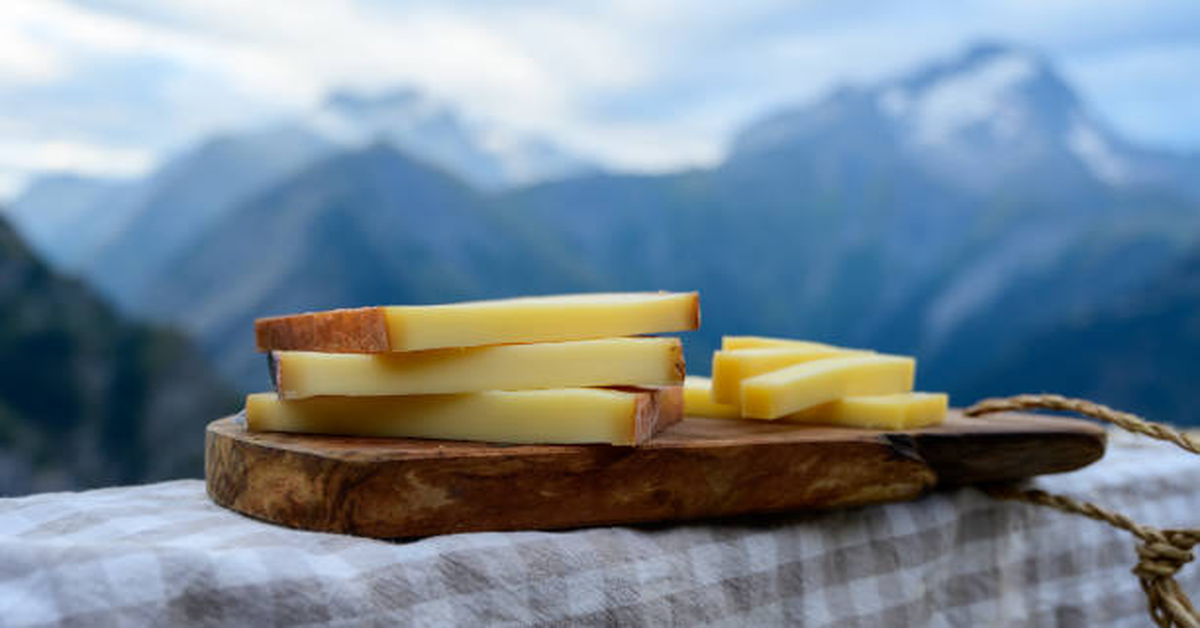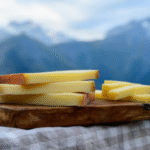In the world of fine cheeses, few names evoke the same sense of tradition, flavor, and craftsmanship as Gruyère cheese. This semi-hard, golden-hued cheese from Switzerland is revered for its rich, nutty flavor, smooth texture, and exceptional melting qualities. From elegant fondue pots to gourmet sandwiches, from culinary masterpieces to simple table platters, Gruyère has earned its place as one of the world’s most beloved cheeses.
But Gruyère is much more than an ingredient — it is a symbol of Swiss heritage, rural craftsmanship, and centuries of cheese-making mastery. This article explores Gruyère in depth: its fascinating origin, production process, nutritional value, culinary versatility, and how it continues to hold a timeless place in both traditional and modern cuisine.
1. The Origins of Gruyère Cheese: A Heritage of Centuries
The history of Gruyère cheese stretches back nearly a millennium, rooted in the verdant valleys and alpine pastures of western Switzerland. It takes its name from the town of Gruyères, located in the canton of Fribourg, where cheese-making traditions have been passed down through generations since the 12th century.
Swiss dairy farmers originally developed Gruyère as a way to preserve milk during the summer months when cows grazed freely in alpine meadows. By transforming milk into cheese, they could store essential nutrients and ensure food security for the long winter months. Over time, the process evolved into an art — combining time, temperature, and skill to produce a cheese of unparalleled flavor and texture.
In 2001, Gruyère received AOP (Appellation d’Origine Protégée) status, a protected designation ensuring that only cheese produced in specific Swiss regions — using traditional methods and local milk — can legally bear the name “Gruyère.” This protection maintains both the authenticity and integrity of this centuries-old product.
2. The Distinctive Character of Gruyère Cheese
What makes Gruyère stand out among hundreds of cheese varieties worldwide is its balanced complexity — a fusion of flavor, aroma, and texture that deepens with time.
Flavor Profile
Gruyère offers a combination of sweet, nutty, and slightly salty flavors with a subtle fruity undertone. Younger Gruyère (aged around 5 months) tends to be creamy and mild, while well-aged Gruyère (aged over 12 months) develops earthy, robust, and slightly tangy notes reminiscent of caramelized nuts and dried fruit.
Texture and Appearance
The cheese has a firm yet supple body with a smooth, dense consistency. The interior is pale yellow with few or no holes, distinguishing it from other Swiss cheeses like Emmental that feature large “eyes.” The rind, naturally formed during aging, is typically hard and brownish-gold.
| Characteristic | Description |
|---|---|
| Country of Origin | Switzerland |
| Milk Type | Cow’s milk |
| Texture | Firm, smooth, slightly elastic |
| Aging Period | 5 months to over 18 months |
| Flavor | Nutty, creamy, slightly sweet, full-bodied |
| Color | Pale yellow interior, golden-brown rind |
| Fat Content | Around 32–35% (in dry matter) |
3. How Gruyère Cheese is Made: The Traditional Craft
The making of Gruyère cheese is a meticulously controlled process that follows time-honored methods. Every stage — from the choice of milk to the ripening environment — influences the final product’s flavor and texture.
Step 1: Milk Collection
Fresh, raw cow’s milk is collected twice daily from cows grazing on natural pasture. The milk is never pasteurized; it is processed within 18 hours to retain its natural microflora, which contributes to Gruyère’s unique flavor.
Step 2: Curdling
The milk is gently warmed to around 32°C (90°F), and rennet — an enzyme that helps coagulate milk — is added. Within minutes, the milk transforms into a soft curd.
Step 3: Cutting and Heating
The curd is cut into small grains using special cheese harps, then gradually heated to 54°C (130°F) while being stirred constantly. This expels whey and concentrates the curd.
Step 4: Molding and Pressing
The hot curds are poured into round molds lined with cheesecloth and pressed under heavy weight to expel remaining moisture. The cheese forms its signature round shape, typically weighing between 25–40 kilograms.
Step 5: Brining
The formed cheese wheels are soaked in a brine bath for 24 hours, which enhances flavor and helps form the protective rind.
Step 6: Aging (Affinage)
Finally, the cheeses are stored in cellars with controlled humidity and temperature. During aging, they are turned and brushed regularly to promote even ripening and rind development. This aging period can last anywhere from 5 months to over 18 months.
| Aging Stage | Duration | Flavor Characteristics |
|---|---|---|
| Young Gruyère | 5–7 months | Mild, creamy, slightly nutty |
| Classic Gruyère | 8–10 months | Balanced, richer taste |
| Reserve Gruyère | 12–18 months | Bold, earthy, slightly tangy |
| Surchoix Gruyère | 18+ months | Deep, complex, caramelized notes |
Each wheel is carefully inspected and graded by experts before being labeled and sold. No artificial preservatives or additives are used — the flavor develops naturally from milk, cultures, and time.
4. Nutritional Profile of Gruyère Cheese
Gruyère cheese is not just delicious; it is also nutritionally rich. It provides an excellent balance of protein, calcium, and vitamins, making it a wholesome addition to a balanced diet — when consumed in moderation.
| Nutrient (per 100g) | Amount | Health Role |
|---|---|---|
| Energy | ~415 kcal | Provides energy for daily activity |
| Protein | 30 g | Supports muscle repair and growth |
| Fat | 32 g | Source of essential fatty acids |
| Carbohydrates | 0.4 g | Minimal carbohydrate content |
| Calcium | 1010 mg | Essential for bone and teeth health |
| Vitamin A | 400 IU | Supports vision and skin health |
| Vitamin B12 | 1.5 µg | Promotes nerve and blood cell function |
| Sodium | 560 mg | Regulates electrolyte balance |
Key Nutritional Insights:
- Gruyère is a high-protein cheese, ideal for active individuals and athletes.
- It is rich in calcium and phosphorus, supporting bone density and strength.
- Contains natural probiotics when made from raw milk, aiding digestion.
- Despite its benefits, Gruyère should be eaten in moderation due to its high fat and sodium content.
5. The Role of Gruyère in Culinary Traditions
Few cheeses offer such versatility in cooking as Gruyère. Its unique combination of melting ability and complex flavor makes it suitable for both gourmet and everyday dishes.
Melting Excellence
Gruyère melts smoothly without separating or becoming oily, which makes it ideal for fondue, gratin, and soufflé recipes.
Common Culinary Applications
| Dish Type | Use of Gruyère Cheese |
|---|---|
| Fondue | The star ingredient in classic Swiss fondue, often mixed with Emmental. |
| French Onion Soup | Melted on top of crusty bread to form a rich, savory topping. |
| Croque Monsieur | Adds depth and creaminess to the traditional French sandwich. |
| Quiches and Tarts | Used in quiche Lorraine or vegetable tarts for flavor and structure. |
| Gratins and Baked Dishes | Ideal for potato gratin, macaroni, and casseroles. |
| Salads and Cheese Boards | Served in cubes or thin slices with fruits, nuts, or honey. |
In haute cuisine, Gruyère is often blended with other cheeses to create layered flavors, or grated over delicate sauces to enhance aroma and creaminess.
6. Gruyère Cheese vs Other Cheeses
Many cheeses share similar characteristics to Gruyère, but none match its unique balance of flavor and texture. Here’s how it compares with some popular alternatives:
| Cheese Type | Origin | Texture | Flavor Profile | Melting Quality |
|---|---|---|---|---|
| Gruyère | Switzerland | Firm, smooth | Nutty, slightly sweet | Excellent |
| Emmental | Switzerland | Semi-hard with holes | Mild, buttery | Excellent |
| Comté | France | Hard | Fruity, nutty | Excellent |
| Jarlsberg | Norway | Semi-soft | Mild, sweet | Good |
| Parmesan | Italy | Hard, crumbly | Sharp, salty | Poor (not a melting cheese) |
Gruyère strikes the perfect balance between firmness and meltability, making it the go-to cheese for culinary applications that demand both flavor and functionality.
7. Storage, Handling, and Serving Tips
Gruyère, like most artisanal cheeses, requires proper care to preserve its flavor and texture.
Storage Tips:
- Refrigeration: Store at 4–6°C (39–43°F).
- Wrapping: Wrap in wax paper or cheese paper, then loosely in plastic wrap.
- Avoid Freezing: Freezing can damage texture and flavor.
- Shelf Life: Typically 2–3 weeks after opening, if stored properly.
Serving Recommendations:
- Bring cheese to room temperature before serving — around 30 minutes out of the refrigerator.
- Pair with crusty bread, fresh fruits (like grapes or pears), or nuts.
- For beverages, Gruyère complements dry white wines such as Chardonnay or Sauvignon Blanc, and also pairs beautifully with light red wines like Pinot Noir.
| Best Pairings | Examples |
|---|---|
| Wine | Chardonnay, Riesling, Pinot Noir |
| Bread | French baguette, rye, whole grain |
| Fruits | Apples, pears, grapes |
| Condiments | Honey, mustard, fig jam |
| Nuts | Almonds, walnuts |
8. Gruyère Cheese in Global Cuisine
Gruyère’s appeal has spread far beyond Swiss borders. Chefs and home cooks worldwide celebrate its versatility in both traditional European and modern fusion cuisines.
- Switzerland: Used in fondue, croûte au fromage, and cheese tarts.
- France: Integral to gratin dauphinois, croque monsieur, and onion soup.
- United States: Popular in gourmet burgers, macaroni and cheese, and soufflés.
- Japan: Increasingly used in western-style bakeries for savory pastries.
Its ability to balance flavor without overpowering other ingredients makes it a favorite among culinary professionals seeking refined taste and texture.
9. Health Benefits and Considerations
While cheese is often seen as indulgent, Gruyère offers numerous health benefits when enjoyed sensibly.
Health Benefits:
- Bone Health: High calcium and phosphorus levels strengthen bones and teeth.
- Protein-Rich: Supports muscle repair and enzyme production.
- Digestive Support: Raw milk Gruyère contains probiotics beneficial for gut health.
- Nutrient Density: Provides vitamins A, D, and B12.
- Satiety: Its fat-protein balance promotes fullness and can aid in portion control.
Considerations:
- Sodium and Saturated Fat: Excess consumption may contribute to hypertension or cholesterol issues.
- Lactose: Contains very low lactose; often tolerated by lactose-sensitive individuals.
- Caloric Density: Best consumed in moderate portions (20–30 g per serving).
10. Sustainability and Regional Importance
Gruyère cheese represents more than just food — it embodies Swiss agricultural heritage and sustainable rural living. The production process supports local dairy farmers, preserves alpine ecosystems, and promotes ethical animal care.
Cows used for Gruyère production graze freely on natural meadows, feeding on grass and herbs that influence the cheese’s complex flavor. The milk’s quality changes with seasons, which gives subtle variations to each batch — a natural reflection of terroir, much like fine wine.
Many dairies still operate as cooperatives, ensuring that profits circulate within local communities. This model helps maintain family farms and preserves the cultural fabric of rural Switzerland.
11. Modern Trends and Global Recognition
Today, Gruyère continues to be one of the most exported Swiss cheeses, loved by chefs, restaurateurs, and connoisseurs worldwide. Modern consumers appreciate not just its taste but also its authenticity — a product untouched by industrial shortcuts.
Recent trends include:
- Organic Gruyère production emphasizing sustainability.
- Aging innovation with longer maturation for more complex flavor.
- Fusion cuisine incorporating Gruyère into Asian and Middle Eastern recipes.
- Cheese education programs teaching pairing and tasting techniques globally.
These trends ensure that Gruyère’s heritage thrives in contemporary gastronomy while staying true to its alpine roots.
12. Conclusion
Gruyère cheese is far more than a culinary ingredient — it is a living symbol of Swiss tradition, craftsmanship, and respect for nature. Its journey from alpine pastures to gourmet kitchens across the world is a testament to the enduring appeal of authentic, well-crafted food.
Every wheel of Gruyère tells a story: of cows grazing under mountain sunlight, of artisans who nurture the curd with patience, and of flavors that deepen as time passes. Whether melted into a silky fondue, grated over a steaming gratin, or savored on its own, Gruyère offers a sensory experience that connects taste with history.
In an age where food often loses its roots, Gruyère stands proudly as a reminder that true flavor is born of time, tradition, and care. Its nutty aroma, creamy texture, and subtle complexity continue to delight palates worldwide — ensuring that this golden Swiss treasure remains timeless.
Frequently Asked Questions (FAQs)
1. What makes Gruyère cheese unique?
Gruyère is unique for its balanced nutty and slightly sweet flavor, firm texture, and exceptional melting quality, making it ideal for both cooking and table use.
2. How long is Gruyère aged?
Traditional Gruyère is aged for 5 to 18 months. The longer it matures, the stronger and more complex its flavor becomes.
3. Is Gruyère cheese healthy?
Yes, in moderation. It’s rich in protein, calcium, and vitamins but should be consumed responsibly due to its fat and sodium content.
4. Can Gruyère be substituted with other cheeses?
In recipes, Gruyère can sometimes be replaced with Comté or Emmental cheese, though flavor and texture will slightly differ.
5. How should Gruyère cheese be stored?
Store it wrapped in cheese paper or wax paper in the refrigerator, and avoid freezing. Bring it to room temperature before serving for best flavor.











